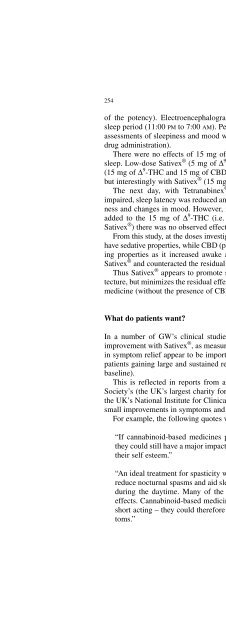3. Umbruch 4.4..2005 - Online Pot
3. Umbruch 4.4..2005 - Online Pot
3. Umbruch 4.4..2005 - Online Pot
Create successful ePaper yourself
Turn your PDF publications into a flip-book with our unique Google optimized e-Paper software.
254 G.W. Guy and C.G. Stott<br />
of the potency). Electroencephalogram (EEG) recordings made during the<br />
sleep period (11:00 PM to 7:00 AM). Performance, sleep latency and subjective<br />
assessments of sleepiness and mood were measured from 8:30 AM (10 h after<br />
drug administration).<br />
There were no effects of 15 mg of ∆ 9 -THC (Tetranabinex ® ) on nocturnal<br />
sleep. Low-dose Sativex ® (5 mg of ∆ 9 -THC and 5 mg of CBD) and Sativex ®<br />
(15 mg of ∆ 9 -THC and 15 mg of CBD), produced a decrease in stage 3 sleep,<br />
but interestingly with Sativex ® (15 mg) wakefulness was increased.<br />
The next day, with Tetranabinex ® (15 mg of ∆ 9 -THC), memory was<br />
impaired, sleep latency was reduced and the subjects reported increased sleepiness<br />
and changes in mood. However, interestingly, when 15 mg of CBD was<br />
added to the 15 mg of ∆ 9 -THC (i.e. following administration of 15 mg of<br />
Sativex ® ) there was no observed effect on daytime sleep latency and memory.<br />
From this study, at the doses investigated, it appears that ∆ 9 -THC appears to<br />
have sedative properties, while CBD (present in Sativex ® ) appears to have alerting<br />
properties as it increased awake activity during sleep of patients taking<br />
Sativex ® and counteracted the residual sedative activity of 15 mg of ∆ 9 -THC.<br />
Thus Sativex ® appears to promote sleep without changing the sleep architecture,<br />
but minimizes the residual effects that may be present if a ∆ 9 -THC-rich<br />
medicine (without the presence of CBD) is used.<br />
What do patients want?<br />
In a number of GW’s clinical studies, patients have reported good overall<br />
improvement with Sativex ® , as measured using the PGIC. Even small changes<br />
in symptom relief appear to be important to the patients, with a subset of the<br />
patients gaining large and sustained responses (e.g. ≥50% improvement from<br />
baseline).<br />
This is reflected in reports from a number of patient groups. In the MS<br />
Society’s (the UK’s largest charity for people affected by MS) submission to<br />
the UK’s National Institute for Clinical Excellence (NICE), the importance of<br />
small improvements in symptoms and sleep quality has been emphasized.<br />
For example, the following quotes were included in their submission:<br />
“If cannabinoid-based medicines provide even minor symptom relief<br />
they could still have a major impact on people’s quality of life and boost<br />
their self esteem.”<br />
“An ideal treatment for spasticity would be short-acting so that it could<br />
reduce nocturnal spasms and aid sleep, but not compromise functioning<br />
during the daytime. Many of the existing treatments have long-term<br />
effects. Cannabinoid-based medicines have the advantage that they are<br />
short acting – they could therefore allow much better control of symptoms.”







